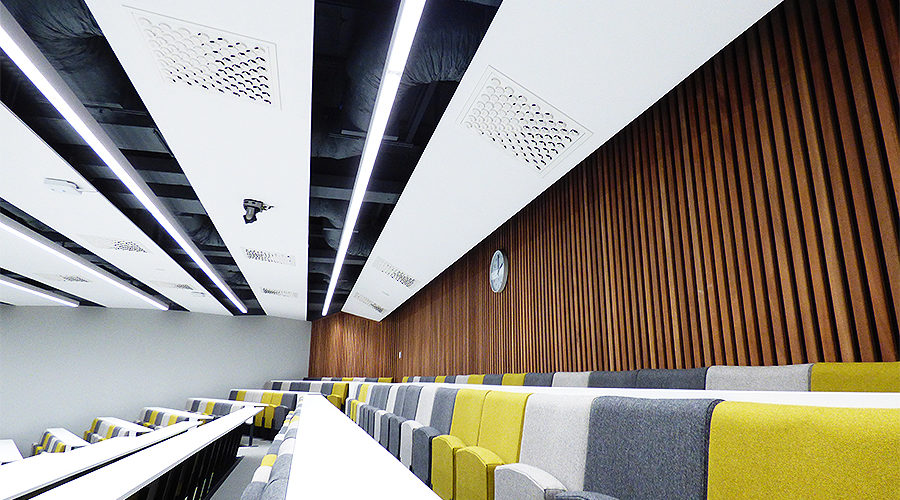Ian Rogers, Sales Director at Gilberts Blackpool, one of Britain’s leading independent air movement specialists, talks to PSBJ about the benefits of hybrid ventilation in public buildings.
Gilberts
Now, probably more than ever, public sector building designers are faced with a difficult balancing act when specifying ventilation. Carbon reduction, energy efficiency and soaring fuel bills are driving the need to build tight, to stop heat escaping. But that has to be balanced against allowing adequate ventilation/ fresh air in.
COVID has focused our minds on indoor air quality (IAQ). But IAQ goes far beyond that – it encompasses our health and wellbeing. A single human being sitting or working in a building generates 70g or more of water vapour/hour – moisture that needs to be expelled to avoid a damp or humid internal environment; then there are the matters of wellbeing – we don’t like to be too hot, or sat in a draught; how many of you reading this have spent hours in a poorly-ventilated air conditioned building and suffered ‘sick building syndrome’?
Then there are the new requirements resulting from the revised Building Regulations Approved Document F (Ventilation) and L (Conservation of Fuel and Power) which came into force last month (June 2022). The first is particularly pertinent, requiring increased ventilation rates (of 10 litres/second/person or 1l/s/m2 floor area, whichever has the higher rate) and inclusion of CO2 monitors to maintain good indoor air quality.
Most of the buildings that will be in use in 2050 – the net-zero carbon target date – are already built, meaning these will have to be remodelled inevitably requiring compromise on the ideal: you are having to work within existing physical and financial constraints rather than starting from scratch. That’s all without taking into account the interior design aesthetics.
The Education & Skills Funding Agency, when it revised Building Bulletin 101 in 2018, was (in hindsight) leading the charge, advising hybrid ventilation as the most effective means of ensuring adequate ventilation and IAQ whilst addressing increased energy usage. It recognised the benefit of the then new technology (which Gilberts pioneered).
Hybrid ventilation – the way ahead?
Hybrid ventilation centres around natural ventilation, complemented by an as/when-needed mechanical boost, usually via a low-energy fan. The system works by mixing the incoming fresh air with the warmer internal exhaust air to maintain compliant IAQ in each stand-alone space.
It is possible to adjust the system to run on 100% fresh air, using an optional heat coil to temper the incoming air temperature (COVID mode). This keeps a cleaner and safer environment, whilst ensuring indoor temperatures are not compromised at all, thereby avoiding cold draughts without the need to boost heating systems to maintain internal comfort levels. Using the heat coil can also eliminate the need for radiators, which optimises useable floor space. Hybrid systems can also be configured to work in conjunction with heat pumps, utilising that source of warmth provide both ventilation and heat for each space. As solely ventilation, they cost as little as £5/space/year to run; even when serving as the heating, the cost is increased by only £2.19/space/year.
As hybrid systems are stand-alone units for each space, they also help comply with the changes in Approved Document F with regard to reducing rigid ducting: there is no ducting at all.
Although initially devised as a solution for educational estates, hybrid ventilation is proving its potential beyond schools. Plymouth City Council’s Endeavour House is a three-storey, open-plan office block aired using hybrid ventilation (Gilberts’ MFS Fusion). The development has been rated BREEAM ‘Excellent’.
The key to any successful ventilation strategy is ensuring all spaces within receive an appropriate level of fresh air.
Beyond hybrid ventilation
Hybrid ventilation is a stand-alone option, with a unit for each designated zone. Being pragmatic, there are inevitably some public buildings that are not suitable for hybrid ventilation systems.
Natural ventilation can often be utilised, provided suitable air paths can be configured. It has worked well for centuries, before global warming was even conceived, and is surely the ultimate zero-carbon solution. It works purely by harnessing the physics of air movement: hot air rises; nature abhors a vacuum, thus drawing fresh air in behind the thermal current. The key to successful ventilation is getting the fresh air where it is needed – the grilles and diffusers, which, with careful selection, can also contribute towards the overall energy efficiency and carbon emissions.
Thermal control may be one answer to prevent wasted energy, and ensure occupants are comfortable, without having to spend money and time connecting ventilation to building management systems. The technique means the ventilation inlet – the swirl diffuser – is a stand-alone solution, that adjusts airflow depending on the internal and supply air temperatures without any supplementary energy/power. It cleverly provides rapid entrainment and mixing harnessing physics principles to achieve a constant comfortable internal environment, whether warming or cooling is required.
Thermally-controlled diffusers – also known as jet nozzles – deliver omni-directional, rotating warm air in the vertical, and cool air in a horizontal direction, thereby eliminating draughts whilst providing rapid and efficient initial warm up and eliminating potential cold spots at low level. Merseyside Police’s new HQ has employed this technology in its atrium, contributing towards the force’s predicted quarter of a million pound savings in operating costs for the building.
Aligning the scales
With a little thought, it is possible to achieve the perfect balancing act, of good ventilation and air quality within an airtight building. The trick for architects, going forward, is to work with experts such as building services consultants and ideally manufacturers. Working with such issues on a daily basis, they have the in-depth knowledge to guide you. You can then be sure that the systems you specify are as energy efficient and environmentally friendly in all aspects as possible. And you will still deliver the appropriate quality of internal air and comfort, and the desired aesthetics.











